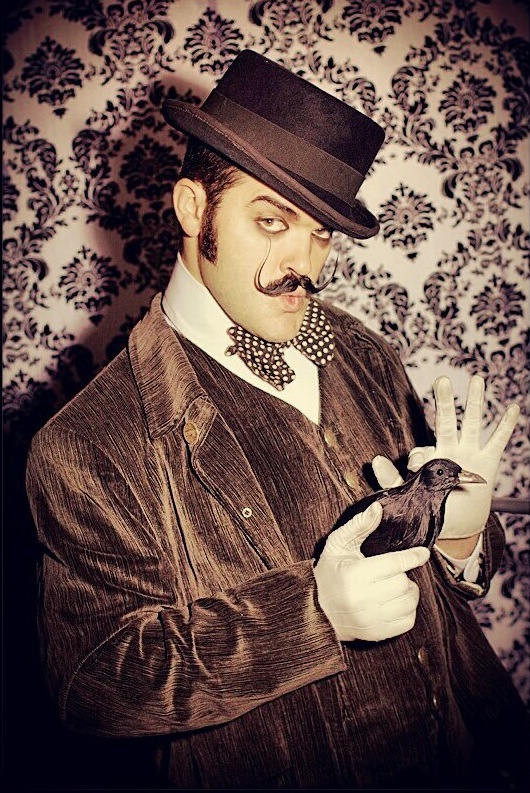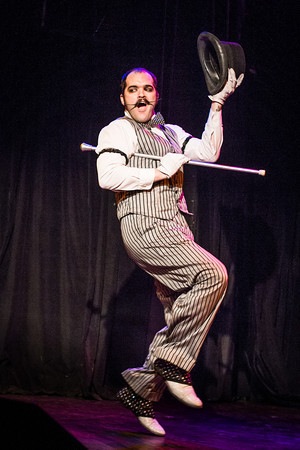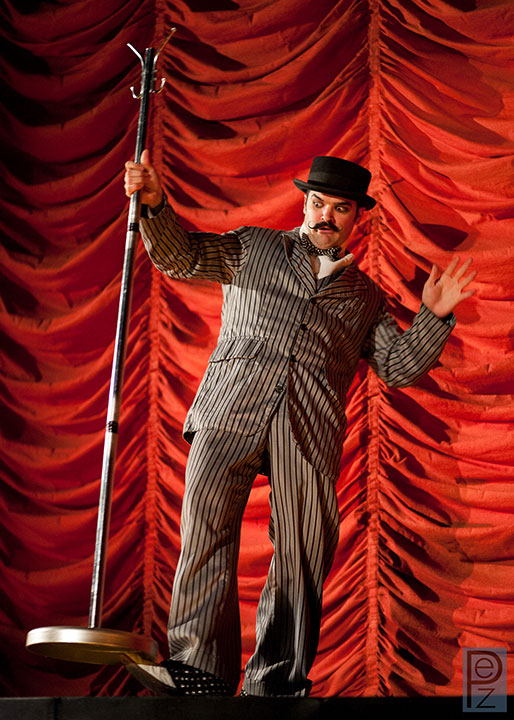by Melanie Crew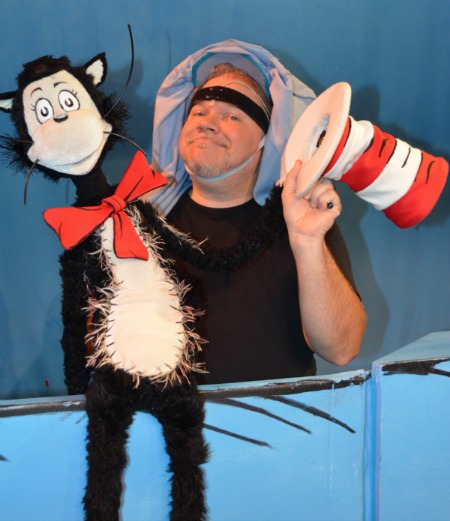
Managing Editor/Contributing Writer
Dolph Amick, a modern renaissance man, (actor for stage and film, puppeteer, composer, musical director and musician) will be throwing down for the kiddies of all ages at The Center for Puppetry Arts, as “The Cat in the Hat” himself, during their production of Dr. Seuss’s beloved children’s tale that has stood the test of time, DR. SEUSS’S THE CAT IN THE HAT in its original 1957 glory, adapted for the puppet stage and directed by the Center’s Artistic Director, Jon Ludwig, running through July 20! For show times and ticket purchases, go here.
Amick, no amateur to the stage (puppet or otherwise), studied at New York University Film School as well as participated in the BFA Acting Program at the University of North Carolina (UNC) – Greensboro. He moved to Atlanta to work for the Kaiser Permanente Educational Theatre, dispensing laughter and health education to children and teens through live performances, which included “piles of puppets”, used during their performances of “Professor Bodywise’s Traveling Menagerie,” at schools and community organizations. During this time he was persuaded to attend an open audition at the Center for Puppetry Arts and has worked hard to hone his rockin’ puppeteering skills ever since! He has joined several casts at the Center during their performances of “Weather Rocks!”, portrayed “Wilbur”, in their performance of “Charlotte’s Web” and so much more!
ATLRetro caught up with Dolph Amick for a quick interview about his awesome experiences with the Center of Puppetry Arts, his portrayal as the walking, talking mischievous feline, “The Cat in the Hat”, his venture into acting and everything you needed to know about puppeteering!
ATLRetro: Studying film at New York University and acting at the University of North Carolina, did you ever see yourself as a ‘behind the scenes’ sort of actor? Would you say the skills involved in stage/film acting versus being a puppeteer are similar or different?
 Dolph Amick: If you’re asking if I anticipated becoming a puppeteer, the answer is certainly no! My formal education and the bulk of my career have been as your standard stage actor. Though puppetry has its own range of unique tools and techniques, I’d absolutely say the skills involved overlap significantly. You need to be able to interpret a script, to follow direction, to develop memorable characters and to use your voice effectively; any mask or movement work you’ve done as an actor will definitely prove helpful. I’d say the primary difference is the fact that, in puppetry, you’re frequently deprived of one of an actor’s most rudimentary tools: the physical appearance of your own body. Your face, your posture, your hands, how you move – those tools that we take for granted as actors are largely unavailable to you as a puppeteer. I mean, I assure you I’m working hard with my body as I move the puppets around, but it’s usually invisible to the audience! (laughs)
Dolph Amick: If you’re asking if I anticipated becoming a puppeteer, the answer is certainly no! My formal education and the bulk of my career have been as your standard stage actor. Though puppetry has its own range of unique tools and techniques, I’d absolutely say the skills involved overlap significantly. You need to be able to interpret a script, to follow direction, to develop memorable characters and to use your voice effectively; any mask or movement work you’ve done as an actor will definitely prove helpful. I’d say the primary difference is the fact that, in puppetry, you’re frequently deprived of one of an actor’s most rudimentary tools: the physical appearance of your own body. Your face, your posture, your hands, how you move – those tools that we take for granted as actors are largely unavailable to you as a puppeteer. I mean, I assure you I’m working hard with my body as I move the puppets around, but it’s usually invisible to the audience! (laughs)
You’ve worked with the Center for Puppetry Arts for quite a while, playing in “Weather Rocks!” and “Charlotte’s Web”. How did you get involved with the Center? What drew you to puppet theatre?
I always found puppetry entertaining and fascinating to watch. I grew up watching the Muppets — I had a “Pigs in Space” lunchbox and all — but I never would have thought of making it my job. I think most people like puppets on some level. I took a one- semester puppetry class offered by Tom Behm at UNC-Greensboro for fun. I had some odd jobs in college using what were actually full-body puppets, amusement park mascots and such. I delivered singing telegrams dressed as a seven-foot-tall stork, entertained at birthday parties as a Teenage Mutant Ninja Turtle (“Donatello”, if you’re wondering) — but I considered them all just acting jobs, really. As it happened, I moved to Atlanta to work for Kaiser Permanente Educational Theatre, and there were some puppets in one of the shows. My director thought I had a pretty good grasp of the puppetry and  encouraged me to go to the general auditions at the Center for Puppetry Arts, telling me “Oh, they hire lots of regular actors!” (laughs) After doing the work for a while, I realized that the technical challenge of puppetry was very appealing to me, and that the shows at the Center were consistently of high quality, which made me very proud. Not to mention that it’s a cool environment with an amazing group of artists. Plus, when I’m able to step back and remember that my job is moving puppets around, it always cracks me up.
encouraged me to go to the general auditions at the Center for Puppetry Arts, telling me “Oh, they hire lots of regular actors!” (laughs) After doing the work for a while, I realized that the technical challenge of puppetry was very appealing to me, and that the shows at the Center were consistently of high quality, which made me very proud. Not to mention that it’s a cool environment with an amazing group of artists. Plus, when I’m able to step back and remember that my job is moving puppets around, it always cracks me up.
What are open auditions like at the Center? Are they as grueling as live theatre auditions? Film auditions?
(laughs) Oh, my! I’d say that if auditions seem grueling, then acting may not be the best career path for a person! But seriously, the Center does try to keep them light. Like any theatre, they’re hoping someone great is going to walk in and they’re rooting for everyone who shows up. It’s very much the same as any theatre audition – maybe a monologue, 16 bars of a song, possibly some cold reading. As far as puppetry goes, they’ll frequently have people recite something simple with a hand puppet — say, part of their monologue, or maybe the alphabet, to see how their lip-sync is, and they’ll take note of how well the person is able to control the puppet’s focus; in other words, how accurately they’re able to make the puppet “look” at a particular target. Sometimes there will be another puppeteer there to move a puppet around with the auditionee, just to see how well you can move with a partner. It’s pretty fun, really.
 How were you chosen for the great opportunity of getting to play America’s favorite walking, talking mischievous feline, Dr. Seuss’s The Cat in the Hat?
How were you chosen for the great opportunity of getting to play America’s favorite walking, talking mischievous feline, Dr. Seuss’s The Cat in the Hat?
(laughs) That’s probably more a question for our artistic director, Jon Ludwig, but I imagine it’s because he thought my voice and energy might suit the role; or maybe just because I have a strong right arm. (laughs) One of the really cool things about puppetry is that we get to play a huge range of characters. As a stage actor with a certain look, I might only be considered for certain roles — but as a puppeteer, I might play a little girl, a marshmallow, a thundercloud – it could be anything. Usually, Jon will bring several different people in and let them read for multiple roles, just to see what manifests itself. I feel very lucky to have been cast as the Cat. I secretly have always wanted to be one of those tall, gangly, acrobatic types like Ray Bolger or Donald O’Connor, so I’m thrilled to get my chance.
Since this adaptation stems directly from Dr. Seuss’s book published in 1957, how would you say your portrayal is different than the other versions on the market? Specifically, the animated musical television special that aired on CBS in 1971 and the major motion picture starring Mike Myers which came out in 2003?
I can’t really comment on the film, which I haven’t seen, or the animated version, which I saw only once way back when I was very little. All I really remember from the animated version is part of a song and the fact that one of the Things had the voice of Thurl Ravenscroft! (laughs) I will say that we used the book as a constant reference. The designers incorporated virtually every element shown in the drawings into the show. Even if a side table or potted plant showed up in only one picture, it was built. We did the same with the Cat. If he was pictured in a certain pose in the book, we worked hard to make sure that image was represented in the show. And the Cat is very expressive in the drawings, so if I ever wondered how to play a scene, I was able to get a lot of information just from looking at the book.
Did you do anything special to prepare for the role? If so, what did you do?
I ate nothing but Fancy Feast for a week. (laughs) Just kidding! I did put in some extra time working on the lines. That’s a part of any show, but because the characters repeat certain phrases frequently, I found it a little easy to get confused initially, especially when I had both hands full trying to balance the Cat with a pile of props on his head and my brain was short-circuiting. Most of the preparation really occurred in rehearsal, because there’s so much partner work in this show. I’m rarely moving the Cat by myself. I usually operate the head, the torso and the left hand, with other puppeteers moving the Cat’s feet and right hand, so there is a huge amount of practice, experimentation, discussion and agreement involved to coordinate it all. I also have a two-year-old, and he and I have been reading the book and watching the DVD of the puppet show for  months.
months.
“It’s fun to have fun, but you have to know how!” exclaims the Cat in the Hat. How does a puppeteer have fun? What’s a day in the life of a puppeteer like?
Puppetry can be physically challenging, and we get pretty exhausted sometimes. But it genuinely is a lot of fun — there’s a lot of teamwork, you get to move around a lot and you’re working with a lot of very funny people doing wacky things on a daily basis. For us, a typical day consists of some combination of two main things: rehearsal and performance. We may rehearse a show up to eight hours a day. Try this sometime at your job. Get something that weighs a few pounds. Lift it over your head. Now keep it there all day! (laughs) Rehearsals can be a bit physically or mentally taxing at times, but they’re generally a lot of fun, and we laugh a lot. On performance days, we come in, do a sound check, warm up a bit, set our props and check our puppets and do the shows. Those days are usually shorter, but represent a very concentrated burst of energy. We try to pack an entire workday’s effort into a few hours’ worth of shows. It’s still pretty sweet to be able to shop for groceries at two in the afternoon, though.
Can you tell folks what your favorite Dr. Seuss character/book was a kid? And why?
Definitely FOX IN SOX. I read that one a lot. I loved the line “I can’t blab such blibber-blubber! My tongue isn’t made of rubber!” It was just fun to say!
What would you say is the most important attribute any puppeteer should have? Is it something you must be born with or can it be learned?
 Hmm. I’d say willingness to work as part of a team is key. The eyes of your director and your fellows are supercritical in puppetry, because you literally cannot see exactly what the audience is seeing, and you rely very heavily on each other for all sorts of assistance. That’s definitely something that takes practice in my opinion. Perhaps one of the most important things might be a certain willingness to be unknown, or at least second banana to an inanimate object. If you’re only in it for your ego, you’ll probably wind up being pretty disappointed. It’s a very rare puppeteer that gets stopped for autographs walking down the street. (laughs)
Hmm. I’d say willingness to work as part of a team is key. The eyes of your director and your fellows are supercritical in puppetry, because you literally cannot see exactly what the audience is seeing, and you rely very heavily on each other for all sorts of assistance. That’s definitely something that takes practice in my opinion. Perhaps one of the most important things might be a certain willingness to be unknown, or at least second banana to an inanimate object. If you’re only in it for your ego, you’ll probably wind up being pretty disappointed. It’s a very rare puppeteer that gets stopped for autographs walking down the street. (laughs)
The Center has put a lot into their production of The Cat in the Hat, as they do with all of their productions, with the production design adaptation for the puppet stage being completed by the uber creative puppet/scenic designers. As one of the six puppeteers in this production, can you tell our readers what a ‘full-bodied rod puppet’ is compared to your average, everyday puppet. Sounds fascinating!
The main Cat in the Hat puppet has a control rod inside his body that I can use to turn his head. There’s a trigger on the rod that opens his mouth, and he’s got short rods on his hands and feet to allow different puppeteers to control his extremities. Our resident puppet builder Jason von Hinezmeyer designed all the puppets, and they’re all brilliant! But the main Cat — “floppy-hat Cat”, as I call him — is my absolute favorite. What I think is so ingenious about the Cat puppet is the way he reflects the fluidity of Seuss’s drawings. The Cat is always drawn as very curvy through the limbs and flexible through the torso, with a distinct grace that seems almost unfettered by bone structure. The puppet is built with beadlike structures under the fur of his arms and legs — almost like a row of marbles or large pearls strung together — which gives them a certain definition of shape and a degree of mass. This allows them to hang in nice curves just like in the book when the puppet moves a hand, but also allows them to bend and wiggle any way we wish. Similarly, the Cat puppet has what is essentially a large, loose spring in his torso (imagine a Slinky) so that his body can flex and compress. Even his removable hat has a spring in it to give it a jaunty jiggle. It’s an immensely versatile puppet in terms of the variety of motion it can achieve.
What can our readers expect when they come out to see Dr. Seuss’s The Cat in the Hat at the Center for Puppetry Arts?
I believe they can expect to be truly delighted! It’s amazing to see these beloved characters that are so familiar to us actually bouncing around the stage, fully realized as tangible creations. It’s a tremendous amount of fun, and I think it’s pretty spectacular.
What’s next for Dolph Amick? More puppeteering in your future? Stage acting? Where can our readers see you next?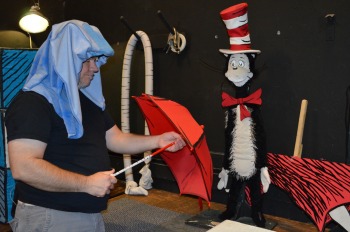
Well, I’m actually in the throes of composing and recording the music for the Center’s upcoming production “Shake a Tale Feather with Mother Goose”, and then I will be musical directing and performing (as a human) in “Pump Boys and Dinettes” at the Georgia Ensemble Theatre. Plus, I’m working on records for two bands, Three Quarter Ale and Burndollies. And yes, there will be more puppetry!
What question do you wish someone would ask you and what’s the answer?
“May I provide you with free on-call babysitting?” And the answer is,
“Yes!”
Can you tell us something you’d like folks to know about you they don’t know already?
I can walk a tightrope. And when I was little, I used to blast John Williams soundtracks while I played.
All photos courtesy of The Center of Puppetry Arts and used with permission.

